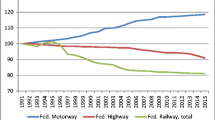Abstract—
The article analyzes development prospects of the transport system of Novosibirsk. An important objective in the development of that city is improving its transport connectivity and reducing the burden on infrastructure, especially road infrastructure. The study includes an analysis of the functioning of public transport in Novosibirsk, formulation of three scenarios based on existing trends in the development of the city’s transport system, and overview of feasible and potential projects in this area. A toolkit for estimating indicators of the city’s transport system is developed. Calculations of the volume and structure of passenger traffic by transport type are performed for the three transport policy scenarios. It is shown that reducing private car use requires significant budget expenditures.
Similar content being viewed by others
REFERENCES
I. N. Pugachev, et al., Strategy for the Development of Transport Systems of Russian Cities (Tikhookean. Gos. Univ., Khabarovsk, 2017) [in Russian].
On approval of the action plan (“road map”) “Improving the quality of the road network of the city of Khabarovsk”: Decree of the Khabarovsk city administration no. 3200 of August 16, 2013, ed. of December 28, 2018. https://docs.cntd.ru/document/465310206. Cited December 26, 2022.
A. E. Gorev, “Development of urban transport systems in large cities,” Transp. Ross. Fed., No. 6 (67), 50–53 (2016).
V. M. Prikhod’ko, “Modern traffic control systems in megacities,” Transp. Ross. Fed., No. 9 (9), 79–81 (2007).
L. Steg, “Can public transport compete with the private car?,” IATSS Res. 27 (2), 27–35 (2003).
M. Kawabata, “Job access and employment among low-skilled autoless workers in US metropolitan areas,” Environ. Plann. A 35 (9), 1651–1668 (2003).
J. Anable, “Complacent car addicts’ or ‘aspiring environmentalists’? Identifying tavel behaviour segments using attitude theory,” Transp. Policy 12 (1), 65–78 (2005).
L. Steg, “Car use: Lust and must. Instrumental, symbolic and affective motives for car use. Transportation research part A,” Policy Pract. 39 (2–3), 147–162 (2005).
V. R. Vuchik, Transport in Cities Convenient for Life (Territ. Budushchego, Moscow, 2011) [in Russian].
G. Beirao and J. A. S. Cabral, “Understanding attitudes towards public transport and private car: A gualitative study,” Transp. Policy 14, 478–489 (2007).
A. Nurdden, R. Rahmat, and A. Ismail, “Effect of transportation policies on modal shift from private car to public transport in Malaysia,” J. Appl. Sci. 7, 1013–1018 (2007).
W. L. Chee and J. L. Fernandez, “Factors that influence the choice of mode of transport in Penang: A preliminary analysis,” Proc. Soc. Behav. Sci. 91, 120–127 (2013).
G. Smith, J. Sochor, and I. Karlsson, “Mobility as a service: Development scenarios and implications for public transport,” Res. Transp. Econ. 69, 592–599 (2018).
On the integrated scheme for organizing traffic in the city of Novosibirsk for 2020–2034: Decree of the mayor’s office of the city of Novosibirsk no. 2200 of July 22, 2020. https://novo-sibirsk.ru/upload/iblock/06b/ 2020_-post_2200.pdf. Cited December 26, 2022.
E. M. Lobanov, “Transport problems of modern large cities,” Transp. Ross. Fed., No. 1 (1), 29–31 (2005).
A. A. Lents, “Formation of the urban planning concept ‘Countable City’,” Archit. Mod. Inf. Technol. 46 (1), 278–289 (2019).
M. E. Koryagin and K. L. Komarov, “Optimization of the urban transport system with various purposes of municipal authorities, transport operators and passengers,” Vestn. Sib. Gos. Univ. Putei Soobshch., No. 4 (47), 36–41 (2018).
Transport strategy of the Russian Federation until 2030 with a forecast for the period up to 2035. Approved by the order of the Government of the Russian Federation no. 3363-r of November 27, 2021. http://static.government.ru/media/files/7enYF2uL5kFZlOOpQh-Ll0nUT91RjCbeR.pdf. Cited December 26, 2022.
Transport strategy of Novosibirsk oblast until 2030. Siberian State University of Railways by order of the Ministry of Transport of the Government of the Novosibirsk Region in partnership with the Urban Planning Laboratory (St. Petersburg) of January 30, 2019. https://mintrans.nso.ru/page/2667. Cited December 26, 2022.
R. E. Artamonov, et al., Evaluation of the Socio-Economic Effect of the Publication of Open Data on the Example of Public Transport Data in Moscow (Vysshaya Shkola Ekon., Moscow, 2015) [in Russian].
Author information
Authors and Affiliations
Corresponding author
Ethics declarations
The authors declare that they have no conflicts of interest.
Additional information
Translated by A. Ovchinnikova
Rights and permissions
About this article
Cite this article
Milyakin, S.R., Skubachevskaya, N.D. Development of the Novosibirsk Transport System until 2045: Analysis and Scenario Forecast. Stud. Russ. Econ. Dev. 34, 363–371 (2023). https://doi.org/10.1134/S1075700723030097
Received:
Revised:
Accepted:
Published:
Issue Date:
DOI: https://doi.org/10.1134/S1075700723030097



